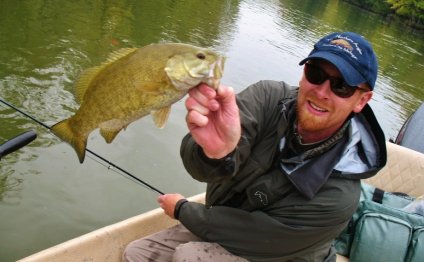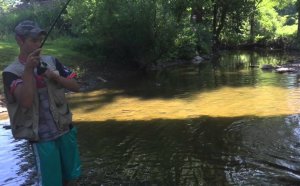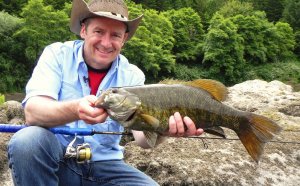
Smallmouth bass Fishing
|
Copyright 2013 - 2015 Little River Outfitters, Inc.
|
NOTE: There are 6 more pages in this article. The links are located on the left. Fly fishermen appear to be targeting smallmouth bass in greater numbers these days. We have been seeing an increase in smallmouth bass attention from our customers over the past few years. I am one of those anglers. If you have not tried fly fishing for smallmouth bass, you should. These hard fighting fish are always a surprise. You think you’ve got a 7 pound bass, only to find out the fish weighs half that when you finally get it in the net. Landing a smallmouth bass is tough because they never give up. These brown bass are full of stamina and determination, probably more than any species I have caught for their size. Everyone agrees, “They never give up”. Smallmouth bass are known for that. Most fly anglers use a 5, 6 or 7 weight rod. I use a 6 weight more often but there is always a 5 and 7 weight rod in the boat for specific circumstances. The 5-weight is used for casting small minnow patterns on a slick water surface. The 7-weight is best for casting larger or heavier flies long distances. For me, the 6 weight is my favorite. Maybe it is just a personal preference. I like using small, lightweight flies for these bass. I almost always use a 9' tapered leader with an 8 pound tippet. I use fluorocarbon leaders for streamers and nylon for floating flies. Tennessee is known as the smallmouth bass state. The smallmouth bass is the official state sport fish. The world record was caught in Tennessee decades ago. According to Tennessee Wildlife Resources Agency (TWRA), “Smallmouth bass are found in nearly all of Tennessee’s reservoirs, however substantial populations have only developed in those reservoirs that have clear, cool water habitats.” Our state has an abundance of lakes that have those conditions. TWRA also states, “In streams, smallmouth bass can live to be 15 years of age, and attain a maximum length of about 21 inches. The average stream smallmouth bass grows to 14 inches in length by age 6. In reservoirs the average smallmouth bass reaches 14 inches in 4 years”. TWRA is managing the smallmouth bass fishery for quality fishing and larger smallmouth bass. Regulations vary from lake to lake or river to river. If you plan to harvest a smallmouth bass, check the TWRA regulations. Catch and release is what I practice for all smallmouth bass. I have never kept one. I probably never will. LAKES We are always waiting in the Spring for the water temperature to rise to 55 degrees. At that temperature, the bass become more active in the lakes. As these fish prepare to spawn, they move from their Winter holding areas in deep water, to shallower water. Fly anglers do much better, fishing in shallow water for obvious reasons. You can use sinking fly lines and reach the fish that are holding in 15 to 20 feet of water in the cold months. I’ve never had much luck doing that. I like to catch smallies in water that is 1 to 6 feet deep. You can do that with a floating fly line. When the surface water temperature reaches the 60’s the bass become even more active. A Black Wooly Bugger is my “go to” fly in the Spring. I tie mine on a #4 Gamakatsu bass stinger hook and wrap 18 wraps of .020 lead-free wire on the hook shank for weight. This fly is especially effective when the bass are moving into shallow water to spawn. At this time, I cast the fly close to the bank and retrieve slowly. As the fly reaches deeper water I just let it sink and wait for a strike still giving the fly some movement with a very slow retrieve. Lately, I’ve been using a large strike indicator, attached where the leader and fly line meet. That helps me detect a strike when the fly is dropping. The Wooly Bugger works well in the lowland rivers near here, specifically Little River and the Little Pigeon River. After the spawn ends, the females rest while the males tend to the beds. After a short resting period, these fish are very hungry. Now that is when this sport gets to be a lot of fun. The males leave the beds and they are hungry too. At this point, bass will take foam flies from the surface. The thrill of watching a 20” smallmouth rise and sip a lightweight fly from the surface is almost more excitement than I can handle. Somehow I endure, over and over again. This feeding frenzy lasts a few weeks on the lakes around here, then we change our tactics. I tie a fly called Byron’s Knucklehead. It was designed to catch smallmouth bass that are feeding on the surface. I prefer black but chartreuse works well on some lakes and rivers. A Knucklehead floats well, even in swift current. It is easy to tie. You can see how to do it by CLICKING HERE. Knuckleheads are also great flies for largemouth bass and very large bluegill or shellcrackers. The fly is tied on a #6 bass stinger hook, so only the large panfish can actually take it. The small fish try but they finally give up. Byron’s Knucklehead is also an excellent fly to use with a dropper. I like to use a Carter’s Rubber Legged Dragon as a dropper. On a lake, the strategy with this fly is to cast it into a likely spot, then wait. They hit the water lightly but the smallies know it is there. Sometimes I give them a little twitch. If a fish is not interested, I cast again a few feet away. I never retrieve these flies. In rivers, I just let them float with the current. They work well in rivers. When the Spring fun is over, we have different ways to catch smallmouth during the Summer and Fall on the lakes. I switch to a shad pattern, usually one I tie using Puglisi EP fibers. These flies are usually 1 ¼” to 2” long. I fish these flies two different ways. First, I move the boat along the shore near trees that have fallen in the water. Smallmouth bass in our lakes like woody debris in the Summer and Fall. I usually cast these lightweight flies near the bank and let them sink. I retrieve enough to keep the fly from snagging something but still move it slowly. We have caught a lot of smallies using this method. When you hook and fight a smallmouth bass that has been feeding on shad, they will often regurgitate their meal. Other smallmouth bass will follow the fish you are fighting to eat the regurgitated shad. We always keep a rod in the boat with... |
Share this Post
Related posts
Smallmouth bass Fishing Ohio
Plenty of private ponds, creeks, streams and rivers in Ohio hold bass. Lake Erie expands the opportunity for anglers to catch…
Read MoreSmallmouth bass Fishing trips
2. Lake St. Clair, Michigan-Ontario — Professional bass ace Kevin Van Dam calls it “the best smallmouth lake in the world…
Read More









